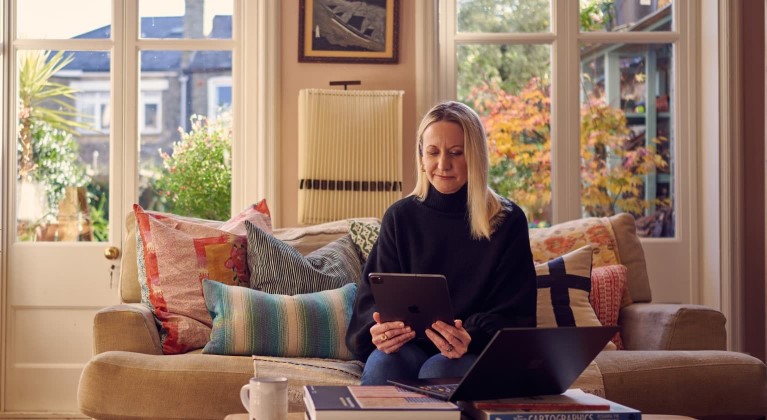Our purpose and strategy
Our purpose is Helping Britain Prosper.

The Scottish Widows Women and Retirement Report shows that women – particularly single mothers – are experiencing struggles when it comes to their pension savings as a result of the rising cost of living.

Scottish Widows’ latest Women and Retirement Report, released last month, revealed that women were being disproportionately impacted by the rising cost of living compared to men – as was the case during the pandemic, which the previous two years’ reports covered.
Many of the reasons behind the pensions gap are due to our societal structures. Many women will take time out of work to raise their families, and this is often the trigger for reducing hours and working part-time to manage childcare. These factors cause a divergence from men in their career prospects and earnings potential, which can have a long-term impact on their lifetime income and, as a result, their workplace pension savings. In addition, women typically live longer than men and have greater social care needs, and therefore need their pension pot to stretch further.
The report finds that, in the current cost of living crisis, women are much more likely than men to be concerned about the rising household bills and to be taking subsequent action to mitigate their outgoings, such as cutting down on essentials like food and utilities. One clear implication of this behaviour is that the current economic conditions are making it even harder for women to close the gender gap in retirement preparations. Single mothers are a particularly financially vulnerable group, with some of the highest rates of concern about the cost of living.
2022 has seen inflation surge to a 50 year high, with the price of necessities such as energy, transport and food rising sharply. Pressures continue to increase with the current annual inflation rate at 9.9%1 which puts significant pressure on disposable incomes, as well as on what people are able to save.
But these concerns about cost of living are not affecting men and women equally. The significant and longstanding gender gap in income means that on average women are likely to have less capacity to absorb the increasing cost of living.
These income differences are driven by structural factors such as over representation in part-time work (72% of part-time workers are women2), greater childcare responsibility and career breaks, and the resulting divergences in career trajectory and earning power. The net result is that the average man earns over £30,900 a year compared to the average woman on over £21,900.
Women are also more likely to cut back in concerning ways more generally, with 38% of women saying they would cut back on essentials, cut savings, take on debt or sell assets (compared to 32% of men).
There is also evidence that the rising cost of living is having a direct impact on retirement savings. 16% of women said that they have cut back on their retirement savings to cope with rising prices. This is similar to men (15%), though within the context that women are less likely to be saving for retirement in the first place. The average reduction in contribution for women is £152 a month but in reality it could be more than this when factoring in employer contributions.
These reductions in savings add up. A woman aged 403 who has reduced her retirement savings by almost £150 per month for a year could have over £3,000 less in her pension pot by the time she retires (including investment returns). This may be more if she cuts her savings by stopping her workplace contributions, in which case she would miss out on employer contributions as well. It becomes even more worrying if the reduction in contributions is never reversed. In that case, the reduction in retirement savings could be over £62,000 by the time they retire.4
Women who have said they are cutting back on their retirement saving
Looking at everyone aged over 35, we can see that men hold more pension wealth than women at every point in their lives. The gap is relatively small for those aged between 35 and 44, but grows rapidly from that point, peaking at retirement.
The gaps that exist for today’s retirees are particularly stark. The average man aged 65 to 74 has over £250,000 of pension assets, compared to less than £150,000 for women. As I mentioned before, the fact that women live longer than men means that they need to be able to live off their retirement savings for longer, and also that they are more likely to need care during their later life.
We’ve previously estimated that as a result, the average woman would need £85,000 more in retirement savings than the average man for a comparable quality in life in retirement. We see this in the fact that concerns about running out of money in retirement are greater for women (61%) than for men (52%).
On a more positive note, there are some early signs of progress: one clear metric is shown in our long-running measure of retirement preparations, the Adequate Savings Index (ASI). It shows that the proportion of women saving adequately (defined as at least 12% of income or a defined benefit scheme) has increased significantly over the last decade, from below 50% to 61% today. However, there’s still a long way to go and a lot more to do in order to achieve real retirement equality.
The rising cost of living is a challenge for everyone, but single mothers are particularly vulnerable, with often only a single source of income and additional costs and responsibilities in raising children. And they are not a small group either. There are nearly 1.7 million single mothers with dependent children in the UK today, and they constitute 20% of households with children (there are also around 200,000 single fathers).5
Single mothers are some of the most likely to report being very concerned about the rising cost of living – 55% report being so, compared to 42% of women in general and 36% of men. Single mothers are also more likely to report cutting back on essentials, with 28% reporting doing so compared to 24% of women and 19% of men.
The current challenges for single mothers compound the difficulties they have in building their financial resilience and long-term savings. In general, single mothers are some of the least prepared for retirement. 72% are concerned about running out of money in retirement, compared to 61% of all women and 52% of men. Single mothers are also far more likely to say they are not a member of a pension, 40% compared to 29% of women.
There’s a particular disparity in financial positions for lone parents (almost 90% of whom are women). Looking specifically at pension wealth we can see that only 64% of lone parents have private pension wealth (compared to 84% of the wider population). Average pension savings are under £15,000 for lone parents compared to over £80,000 for couples and £57,000 for single households.6
This picture reflects the multi-faceted challenges that single parent households can face. A combination of lower income and higher costs means that single parent households spend 87% of their income, compared to about 67% for two-parent households – meaning that single parents will have very little disposable income to fall back on.7 Given these conditions, it is particularly concerning that nearly a fifth (19%) of single mothers say they are reducing retirement savings in response to the rising cost of living.
The issues facing single mothers have no single solution. Inequalities in income are not easily resolved but there is clearly more that can be done to support single parents, particularly provision of childcare for those with young children, allowing equal access to the workplace. At the same time, the challenges in building up assets mean that many single mothers will be particularly reliant on sources of income including the state pension and it becomes especially important that they have sufficient work record to maximise their entitlement.
There’s still a lot more to be done to fully close the gap. The cost of living crisis is having a disproportionately worse impact on women than society at large, and there needs to be more support for childcare, which is a significant financial challenge and barrier to wider equality.
The findings from this year’s Women and Retirement Report reinforce the calls to action of the Scottish Widows Retirement Report published in June 2022. It remains imperative for the UK Government to support households through the rising cost of living, and we welcome the recent focus on the need to grow the economy, which is fundamental to driving up long-term real wages. The call for a gradual rise in automatic enrolment contributions is also necessary for helping to secure good retirements for all, and bridge some of the gender gap.
By directly addressing the societal structures that exacerbate the pensions gender gap, we’ll stand a better chance of closing it. Cost of living may be front of mind at the moment, but ultimately the shortfall was huge even before the current crisis, and before the Coronavirus pandemic. There are some significant measures that we would like to see the UK Government and wider industry come together to deliver to help address the societal blockers of pensions equality:
These are not quick fixes, but through these measures we believe that some of the long-term issues that make retirement outlooks much bleaker for women could be effectively addressed. It’s only through concentrated efforts to close the pensions gender gap that we’ll be able to bring about a better retirement for everyone.

Chief Executive, Embark Group and Managing Director, Pensions, Stockbroking & Distribution
Jackie has over 25 years experience in the financial services industry, with specialism in life and pensions, and a focus on leading customer and client facing teams. She joined LBG in 2010 to lead one of our large operations teams, fulfilling a number of leadership roles before assuming her current position in 2018, where she is responsible for pension proposition development, distribution of Scottish Widows flagship pensions and protection products, and the Halifax Share dealing business.
Jackie is a huge advocate of raising awareness of financial resilience, particularly for women. She is an industry-recognised advocate for driving societal and political change that will help close the gender pensions gap.
1. Nationwide Building Society: Nationwide HPI News – Data & Resources (nationwidehousepriceindex.co.uk)
2. ONS Labour Force Survey, 2022 May-July period: EMP01 NSA: Full-time, part-time and temporary workers (not seasonally adjusted) – Office for National Statistics (ons.gov.uk)
3. Average for women aged 35–44 (Scottish Widows 2022 Women in Retirment Report)
4. Assuming a retirement age of 65, a current age of 40 and a 2% real return on investments (Scottish Widows 2022 Women in Retirment Report)
5. ONS, Families and households, Table 1, 2021
6. ONS, Wealth and assets survey, 2018-2020
7. See the ONS: Parents more likely to report increases in their cost of living – Office for National Statistics (ons.gov.uk)

From developing tools to give app users more control over their spending to overdraft support for those struggling with their finances, these are some of the ways we’re supporting customers through the rising cost of living.
Jasjyot Singh, OBE | 20 Oct 2022

Today nearly half (46%) of UK pension holders have lost track of some of their pension pots, according to new research from Scottish Widows.
Robert Cochran | 15 Nov 2022

Maria Nazarova-Doyle, Head of Responsible Investments and Stewardship at Scottish Widows, explains the crucial role the UK’s nearly £3 trillion in pensions play in driving responsible, nature-focused investment.
Maria Nazarova-Doyle | 27 Apr 2023
Popular topics you might be interested in